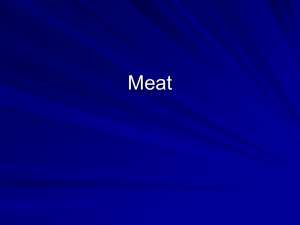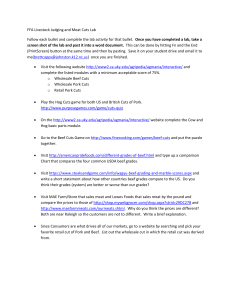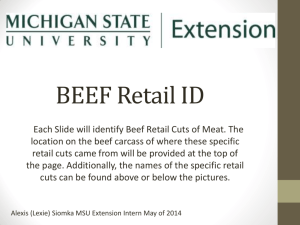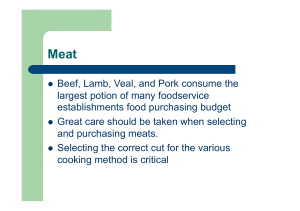Quality of the Beef
advertisement
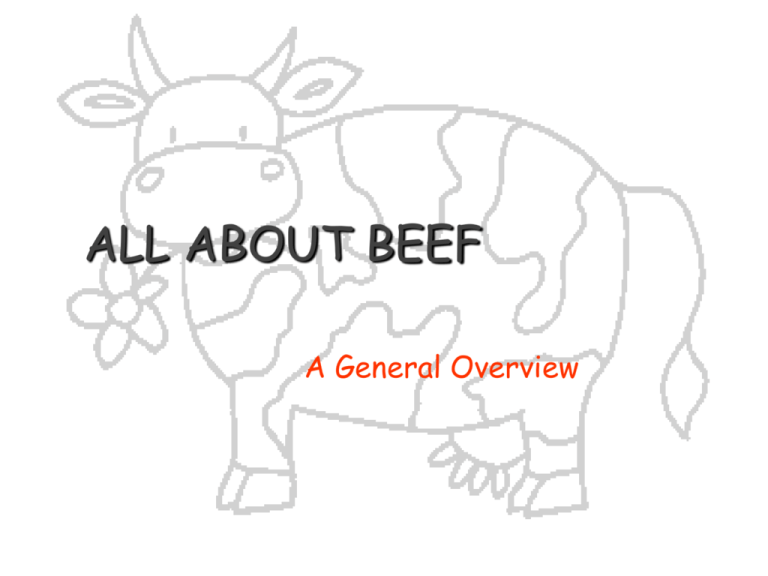
ALL ABOUT BEEF A General Overview Evans, T.M. and Greene, D. (1973). The Meat Book. p. 1. Meat has been prepared since the beginning of time. This illustration, from an Egyptian tomb, shows the cutting of meat. What is Meat? Meat is considered to be the flesh of an animal used as food; fish and poultry are not usually called meat. Red Meats: Beef Pork Veal Lamb Fish Poultry Meat and Alternatives Eggs www.johndrow.com Peanuts and peanut butter www.j-walk.com Dried beans and peas Nuts Nutrients in Beef Protein - For growth, repair, and replacement of body cells, and tissues. complete - animal sources incomplete - plant sources which must be used in combination Eg. peanut butter and bread B Vitamins - eg. Thiamine, niacin, riboflavin, folic acid, and cobalamin(B12) Maintains healthy skin. Normal function of the nervous system. Iron (Mineral) - Necessary part of hemoglobin in red blood cells. Transports oxygen and carbon dioxide. Prevents iron-deficiency anemia. Inspection www.beefinfo.org The meat inspection stamp tells the consumer that the meat has been federally inspected and that it meets the requirements for food safety. Grading Based on the age, quality, and the proportion of fat to lean meat. Colour, texture, and firmness of lean and fat are also taken into account. http://www.5min.com/Video/Grades-ofBeef-140614487 Marbling www.beef4you.com Refers to the microscopic streaks of fat throughout the lean part of the red meat. Grades USDA: Prime Choice Select The Structure of Beef Muscle fibres Bands of connective tissue (tough fibres which hold the muscle fibres together). Two types: Collagen Elastin Collagen - White bands of connective tissue which can be softened to gelatin by moist heat cooking. Elastin - Yellow, tough bands of connective tissue which cannot be softened. Factors Affecting the Tenderness of a Cut of Beef Location of Cut on the Carcass Age of the Animal Length of Aging Time Amount of Marbling Quality of the Beef • Location of Cut on the Carcass Tender Less Tender Medium Tender • Age of the Animal Beef from younger animals will be more tender (top picture), due to less connective tissue. Older animals will have received more exercise. • Length of Aging Time Carcasses are allowed to hang for approximately 7 10 days. Enzymes in the beef help to tenderize the connective tissues. • Amount of Marbling The more marbling the beef has, the more tender it will be. • Quality of the Beef The higher the quality, the more tender it will be. How Much to Buy? Boneless meat - 1/4 lb./serving Bone-in meat - 1/2 lb./serving Bony meat - 3/4-1 lb./serving When shopping for meat, consider: amount of bone, fat, and gristle cooking loss serving size Cooking Beef Before you start . . . • do you know where the cut comes from on the animal in order to determine its degree of tenderness? • do you know whether a dry or moist heat method is required? • do you know which specific cooking method to use? The answer to those three questions could mean the difference between a sumptuous repast and a total disaster! If you want to go for the sumptuous repast then pay close attention . . . Wholesale Cuts of Beef Tender Cuts of Beef Tender areas include the Rib, Loin and Sirloin. Medium Tender Cuts Medium Tender areas include part of the Hip area. Less Tender Cuts Chuck Plate Brisket/Fore Shank Flank and the Hind Shank Meat is often the most expensive item on the food bill. Be a wise consumer. Learn how to judge quality, cuts, grades to get the most for your money. Less expensive cuts give the same nutrients as the more expensive cuts. Chuck Cuts from the Chuck include the Blade and Cross Rib. They may come in the form of roasts or steaks. eg. Blade Roast, Cross Rib Roast, Blade Steak, Cross Rib Steak, Pot Roast Brisket/Fore Shank Brisket may be flat or rolled. Shank or heel cuts come from either the Fore Shank or the Hind Shank. Plate Short Ribs come from the Plate area of the carcass. Flank Flank Steak is the most common cut from the Flank. Hip/Hind Shank Round steak, Sirloin Tip steak, Eye of the Round, Rump Roast, and the Baron of Beef are all examples of cuts from the Hip. Shank and heel cuts come from the leg of the animal. Sirloin Sirloin Steak, regular or boneless, is the most common cut from this area. Loin The loin is known for its steaks Wing, T-bone, Porterhouse, Tenderloin (Filet Mignon), and Strip Loin. It is also the most expensive section of the carcass as it is the most tender. Porterhouse Steak www.appealinggifts.com T-Bone Steak www.boitrearecettes.infinit.net Wing Steak As one moves down the carcass more tenderloin is found on the steak (right side of bone). Rib Cuts from the Rib include Rib Eye Steak, Prime Rib Roast and Prime Rib Steak. This area is also expensive because of its degree of tenderness. A Word about Ground Beef and Stewing Beef www.peacefulpastures.com www.boitearecettes.infinit.net Ground beef and stewing beef may come from either medium tender or less tender cuts where the meat has been mechanically ground to tenderize it. In summary . . . . www.ca.uky.edu You May Know Them by Their Bones ! Whereas, bones from less tender cuts of meat are round and knobby. Bones from tender cuts of meat are flat. Evans, T.M. and Greene, D. (1973). The Meat Book. p. 19. To Cook Tender Cuts of Meat . . . Use dry heat methods such as: roasting frying broiling barbecuing There is no liquid nor is there a lid. Steam is not needed because there is little connective tissue. Tender cuts are more flavourful when cooked this way. Ways to Tenderize Less Tender Meat Use moist heat - lid holds in the liquid that has been turned to steam to soften connective tissue. Mechanical - breaks or cuts connective tissue. Examples include grinding, pounding, scoring, and cubing. • Chemical - acid dissolves connective tissue. Examples include marinating meat in tomato sauce. • To Cook Less Tender Cuts of Meat . . . Use moist heat methods such as : stewing pot roasting oven or top-of-the-stove braising Liquid and a lid are used to produce steam which penetrates the meat and softens the connective tissue. To Cook Medium Tender Cuts of Meat. . Either dry or moist heat methods may be used. However, use moist heat for extra tenderness. References Evans, T.M. and Greene, D. (1973). The Meat Book. New York: Charles Scribner’s Sons. 310 pp. Beef Information Centre Personal notes Foods for Today: Text Chapter 36
